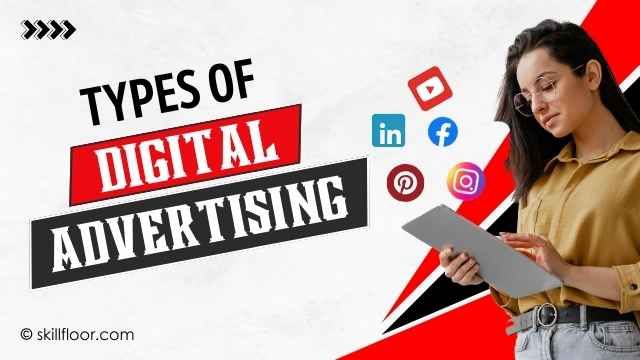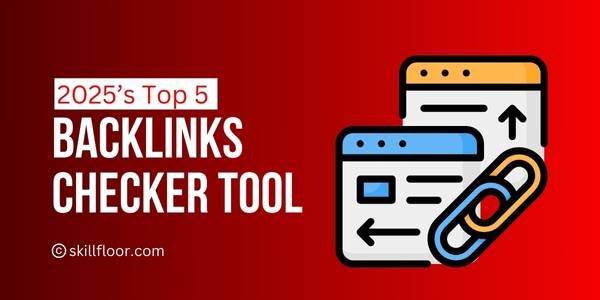Types of Digital Advertising
The diverse types of digital advertising, from PPC and display ads to influencer marketing. Learn how to choose the right format for your goals.

Digital advertising is a quickly changing environment, and as a digital marketing expert, I’ve seen directly how diverse and adaptable the ecosystem is. Whether you're a marketer trying to get traffic, boost brand awareness, or enhance conversions, understanding the various forms of digital advertising is essential to running effective campaigns.
Let’s explore the different types of digital advertising and how they function in the broader context of marketing goals.
The Shift to Digital Advertising
The marketing world has shifted significantly over the past decade. Traditional advertising avenues like print, TV, and radio have given way to a more interactive, personalized, and measurable alternative—digital advertising. Brands now have more control over their message, who sees it, and how it performs. With this shift, advertisers can target precise demographics and adjust campaigns in real time based on performance.
This digital transformation has led to a variety of ad types designed to meet specific marketing goals, whether that’s raising brand awareness, driving clicks, or directly increasing sales.
Overcome Options
As digital platforms multiply, so do the ad formats. There are social ads, search ads, video ads, and more. While this offers marketers flexibility, it also creates complexity. Knowing which form of digital advertising suits your campaign can be daunting. Should you prioritize social media ads or focus on search engines? Should your campaign go for display banners or video ads? Each has unique benefits, but their effectiveness largely depends on the strategy and objectives behind them.
How Do You Choose the Right Type of Digital Advertising?
With so many options on the table, the question becomes: How do you select the right type of digital advertising for your business goals? More importantly, which format fits where in the customer journey?
Breakdown of Digital Advertising Types
Let’s dive into the most common digital ad formats, their best-use cases, and how to align them with your objectives:
1. Search Engine Advertising (PPC)
Search Engine Advertising, often referred to as Pay-Per-Click (PPC), is a key method for quickly attracting visitors to your website. When users search for keywords related to your offerings, your ads can appear at the top of the search results, making it easy for them to find you. Google Ads is the most widely used platform for this type of advertising, but others like Bing and Yahoo also play a role.
This approach is ideal for driving traffic, generating leads, and meeting conversion goals.
Cost model: You only pay when someone clicks on your ad, allowing you to manage your budget effectively.
Platforms: The main platforms include Google, Bing, and Yahoo.
Use case: For instance, if you operate a plumbing business, bidding on local keywords like “emergency plumber near me” ensures your ad appears when potential customers are searching for urgent plumbing services.
Additional Points:
-
Targeting Options: PPC allows for precise targeting. You can choose specific demographics, locations, and even the time of day your ads appear. This helps ensure that your ads reach the most relevant audience.
-
Ad Extensions: Google Ads offers features like site link extensions, call buttons, and location info, enhancing your ads’ visibility and providing more information to potential customers.
-
Measurable Results: With PPC, you can easily track performance metrics, such as click-through rates (CTR) and conversion rates, allowing you to assess and optimize your campaigns.
-
Budget Control: You have full control over your advertising budget. You can set daily or monthly limits, adjusting as needed based on performance.
-
A/B Testing: PPC campaigns allow you to test different ad copies and keywords to see what works best, optimizing your efforts for better results over time.
Overall, PPC is a powerful tool for businesses looking to generate immediate traffic and achieve measurable results quickly.
2. Display Advertising
Display ads are visual advertisements that appear on websites, apps, or videos. They can take various forms, including banners, pop-ups, and video placements. Commonly, these ads show up as banner ads on publisher websites or as sidebars on news portals.
Best For:
-
Brand Awareness: Display ads are effective for introducing your brand to a wider audience. They help create recognition and familiarity, which can influence future purchasing decisions.
-
Retargeting: They can remind users who have visited your website about your products, encouraging them to return and complete a purchase.
Cost Model:
-
Cost-per-Thousand Impressions (CPM): You pay for every thousand times your ad is displayed, regardless of clicks.
-
Pay-Per-Click (PPC): You pay only when someone clicks on your ad, making it a cost-effective option for driving traffic.
Platforms:
-
Google Display Network: This platform allows you to display ads across a vast network of websites, reaching millions of users.
-
Facebook Audience Network: This extends Facebook ads to other apps and websites, providing more visibility.
Use Case:
If you’ve recently launched a new product, display ads can be a great way to ensure your brand gets broad visibility. They can reach potential customers while they browse other content online. Additionally, if you’re promoting an event or a special offer, display ads can effectively capture attention and drive engagement.
Additional Benefits:
-
Visual Appeal: The use of images, colors, and graphics can grab attention and convey messages quickly.
-
Targeting Options: You can target specific demographics, interests, and behaviors to ensure your ads reach the right audience.
-
Performance Tracking: Most platforms provide analytics to track impressions, clicks, and conversions, allowing you to optimize your campaigns for better results.

3. Social Media Advertising
Social platforms like Facebook, Instagram, LinkedIn, and TikTok provide highly targeted advertising options that can significantly enhance your marketing efforts. Social media ads are designed to blend seamlessly into users’ feeds, making them less intrusive and more engaging.
Key Features of Social Media Advertising:
-
Demographic Targeting: You can focus your budget on specific audiences based on factors like age, location, interests, and behaviors. This targeting can even extend to significant life events, such as new parents or recent graduates, allowing for highly relevant messaging.
-
Ad Formats:
-
Image Ads: Simple and effective, these ads use eye-catching visuals to grab attention.
-
Video Ads: Engaging video content can showcase your brand's personality and product benefits effectively.
-
Carousel Ads: These allow you to display multiple images or videos in one ad, ideal for showcasing a range of products or telling a story.
-
Stories Ads: Full-screen ads on platforms like Instagram and Facebook that are temporary but can create a sense of urgency.
-
Collection Ads: These let users browse a selection of products directly within the ad, streamlining the shopping experience.

Best Uses:
-
Engagement: Social media is perfect for fostering interactions with your audience. Polls, quizzes, and comment prompts can increase user engagement.
-
Conversions: With clear calls to action, you can drive users to your website or landing page, facilitating sales or lead generation.
-
Brand Awareness: Well-crafted ads can introduce your brand to new audiences, building recognition and loyalty.
Cost Models:
-
Pay-Per-Click (PPC): You pay for each click on your ad, making it a cost-effective choice for driving traffic.
-
Cost Per Mille (CPM): You pay for every 1,000 impressions, useful for maximizing reach and visibility.
Platforms to Consider:
-
Facebook: Best for broad targeting and diverse ad formats.
-
Instagram: Ideal for visually appealing brands; strong engagement features.
-
LinkedIn: Effective for B2B marketing and professional services.
-
Pinterest: Great for lifestyle brands, especially in fashion, food, and home decor.
-
X (formerly Twitter): Useful for real-time engagement and trending topics.
-
TikTok: Perfect for reaching younger audiences with creative, short-form video content.
Use Case Example:
For a clothing brand, Instagram’s carousel ads can effectively highlight multiple products in a single ad. This format encourages users to swipe through various styles, increasing interaction and interest. By showcasing lifestyle images or videos of the clothing in use, you can create a connection with potential customers, leading to higher engagement and conversion rates.
By leveraging these features and strategies, businesses can make the most of their social media advertising efforts to meet their specific marketing objectives.
4. Video Advertising
With platforms like YouTube, video advertising is a key tool for marketers. Ads can run before, during, or after video streams, effectively delivering memorable messages. The focus should be on creating short, engaging content that fits the viewing experience.
Best for:
-
Brand Storytelling: Conveying values and narratives.
-
User Engagement: Encouraging viewer interaction.
Cost Model:
-
Cost-per-view (CPV): Pay when a viewer watches the ad.
-
Cost per mille (CPM): Pay based on impressions (1,000 views).
Platforms:
-
YouTube: Offers various ad formats.
-
Vimeo: Ideal for high-quality content.
-
Facebook Watch: Integrates with social media.
-
Instagram Reels: Great for quick, engaging content.
Use Case:
A lifestyle brand could create a 30-second ad showing real customers using their product, driving awareness and emotional connection.
Additional Tips:
-
Analytics: Track engagement to improve future campaigns.
-
A/B Testing: Experiment with different styles to see what works best.
-
Call to Action: Encourage viewers to visit a website or make a purchase.
These strategies can enhance visibility and build stronger connections with customers.
5. Native Advertising
Native ads are designed to blend in with the content surrounding them. They are typically placed within editorial content, matching the tone and style of the platform. Native ads can be articles, videos, or sponsored content, giving advertisers a way to deliver value while still promoting their brand.
Best for:
Building trust and credibility.
Cost Model:
Cost Per Mille (CPM) or Pay Per Click (PPC).
Platforms:
Outbrain, Taboola, social media platforms.
Use Case:
A financial service company can sponsor educational articles on personal finance in reputable news outlets to enhance trust and authority.
Key Points:
-
Higher Engagement: Native ads often lead to more meaningful interactions due to their informative nature.
-
Storytelling: They enable brands to connect emotionally with audiences.
-
Targeting: Fine-tuned audience targeting increases conversion potential.
-
Performance Tracking: Analytics tools help measure campaign success in real time.
-
SEO Benefits: Engaging content can drive traffic and improve search visibility.
In summary, native advertising effectively promotes brands while fostering trust and engagement.
6. Email Advertising
Email marketing is a direct way to reach your audience and can really help drive sales. Here’s a simple breakdown:
Key Features of Email Marketing
-
Personalization: You can customize emails with people’s names and information about what they like, making them feel more special.
-
Segmentation: You can group your audience based on things like age or interests. This helps you send messages that matter to each group.
-
Automation: You can set up emails to go out automatically. For example, you can send a welcome email to new subscribers or reminders to people who haven’t signed up for an event.
-
Analytics: You can track how many people open your emails and click on links. This data helps you improve future emails.
Best Uses
-
Direct Communication: Quickly share news, product launches, or important updates.
-
Driving Conversions: Promote special offers or discounts to encourage people to buy.
Cost Model
-
Cost-per-send or CPM: You may pay based on how many emails you send or how many people see them.
Popular Platforms
-
Mailchimp: Easy to use, perfect for beginners, with many templates.
-
Campaign Monitor: Focuses on good design and detailed results.
-
ActiveCampaign: Combines email marketing with smart automation tools.
Use Case Examples
-
E-Commerce Brands: A clothing store can email customers who left items in their shopping cart, offering a discount to complete their purchase.
-
Event Promotion: A gym can send invites to members about new classes based on their past interests.
-
Customer Retention: A subscription service can reach out to customers who haven’t used it in a while with a special offer.
-
Content Sharing: A blog can send a weekly newsletter to highlight recent articles, encouraging readers to visit the site again.
Using these strategies, email marketing can help keep customers engaged and boost sales.
7. Influencer Marketing
Influencer marketing uses the trust that influencers have built with their followers to help brands connect with specific audiences. The key is to choose influencers whose followers match your brand.
Best For:
-
Reaching Targeted, Engaged Audiences: Influencers have dedicated fans who trust their opinions, making it easier to find potential customers.
Cost Model:
-
Paid Sponsorships or Product Partnerships: Brands can pay influencers to promote their products or send them free products in exchange for promotion. Costs can vary based on the influencer's popularity.
Platforms:
-
Instagram, TikTok, YouTube: These platforms are perfect for influencer marketing. Instagram is great for eye-catching images, TikTok for fun short videos, and YouTube for detailed tutorials.
Use Case:
For example, a beauty brand could work with a skincare influencer to create a tutorial. This shows how to use their products, which can lead to quick sales and build long-term loyalty as followers see the results.
Additional Tips:
-
Micro-Influencers: Smaller influencers often have highly engaged followers and may provide better results for your budget.
-
Authenticity: It’s important that influencers genuinely like your brand. Real connections lead to better engagement.
-
Campaign Tracking: Use tools to measure how well your influencer campaigns are doing, looking at engagement, website visits, and sales.
-
Long-Term Relationships: Working with influencers over time can create stronger connections and more genuine promotions.
By choosing the right influencers and creating authentic partnerships, brands can reach new audiences, boost visibility, and drive sales.
8. In-App Advertising
As more people spend time on their mobile devices, in-app ads have become popular. These ads show up inside mobile apps and are particularly effective in games and social media. Here’s a simple breakdown:
Key Benefits
-
High Engagement: Users are more likely to interact with ads while using an app.
-
Targeted Reach: You can show ads to specific groups of people based on their interests.
Best For
-
Capturing Mobile Users: Great for reaching people who are always on their phones.
-
Driving App Downloads: Useful for promoting new apps or features.
Cost Model
-
Cost Per Click (CPC): You pay when someone clicks on your ad.
-
Cost Per Mille (CPM): You pay for every thousand times your ad is shown.
Popular Platforms
-
Google AdMob: A top choice for mobile app ads with a wide reach.
-
Facebook Audience Network: Lets you extend Facebook ads to other apps.
-
Unity Ads: Works well for gaming apps with interactive ads.
Use Case
If your audience is fitness fans using a fitness app, you could place ads for your sportswear during busy times, like early mornings or after work, when users are likely to be exercising.
Additional Considerations
-
Ad Formats: You can use banners, full-screen ads, ads that blend with the app, or video ads, depending on your goals.
-
User Experience: Make sure ads don’t disrupt the app experience. Good placement can enhance engagement.
-
Tracking Performance: Keep an eye on how well your ads are doing and adjust them to improve results.
In-app advertising is a smart way to connect with mobile users and should be part of your digital marketing strategy.
9. Programmatic Advertising
Programmatic advertising uses machine learning and AI to automate the buying of digital ads. This helps target users effectively by analyzing lots of data. It allows for real-time bidding, ensuring your ads reach the right people at the right time.
Benefits of Programmatic Advertising
-
Efficiency: Automation makes the ad buying process quicker and easier.
-
Data-Driven: It uses data to help advertisers make smart choices about where and when to show ads.
-
Scalability: You can easily adjust your campaigns to fit your needs.
Best for:
-
Large-Scale Campaigns: Perfect for brands with big budgets wanting to reach many people.
-
Precise Targeting: Great for targeting specific audiences based on interests or online behavior.
Cost Models:
-
CPM (Cost Per Thousand Impressions): Pay for every thousand times your ad is shown.
-
CPC (Cost Per Click): Pay only when someone clicks on your ad.
-
CPV (Cost Per View): Pay for each time someone watches your video ad.
Platforms:
-
DoubleClick: Part of Google, it offers tools for buying and analyzing ads.
-
The Trade Desk: A popular platform that helps manage programmatic ad campaigns.
Use Case:
A large beverage company could use programmatic advertising to show different versions of an ad in various regions. For example, it might highlight local flavors or seasonal promotions, making the ads more relevant to each audience. This way, the company can constantly improve its campaigns based on real-time data.
Additional Considerations:
-
Fraud Prevention: Using technology to prevent ad fraud is important.
-
Privacy Regulations: Following laws about data protection helps maintain trust with users.
-
Creative Flexibility: Trying out different ad styles can lead to better engagement.
By using programmatic advertising, businesses can run more targeted and effective marketing campaigns.
Selecting the right type of digital advertising boils down to understanding your objectives, audience, and budget. Each platform and ad format has its strengths and weaknesses, so it's essential to align your strategy with the specific goals of your campaign. Whether you’re aiming for brand awareness through video ads, driving conversions via PPC, or building relationships with native content, the key is experimentation and data-driven optimization. Digital advertising isn’t a one-size-fits-all solution; it’s a constantly evolving ecosystem that, when used correctly, can significantly enhance your business outcomes.




























































